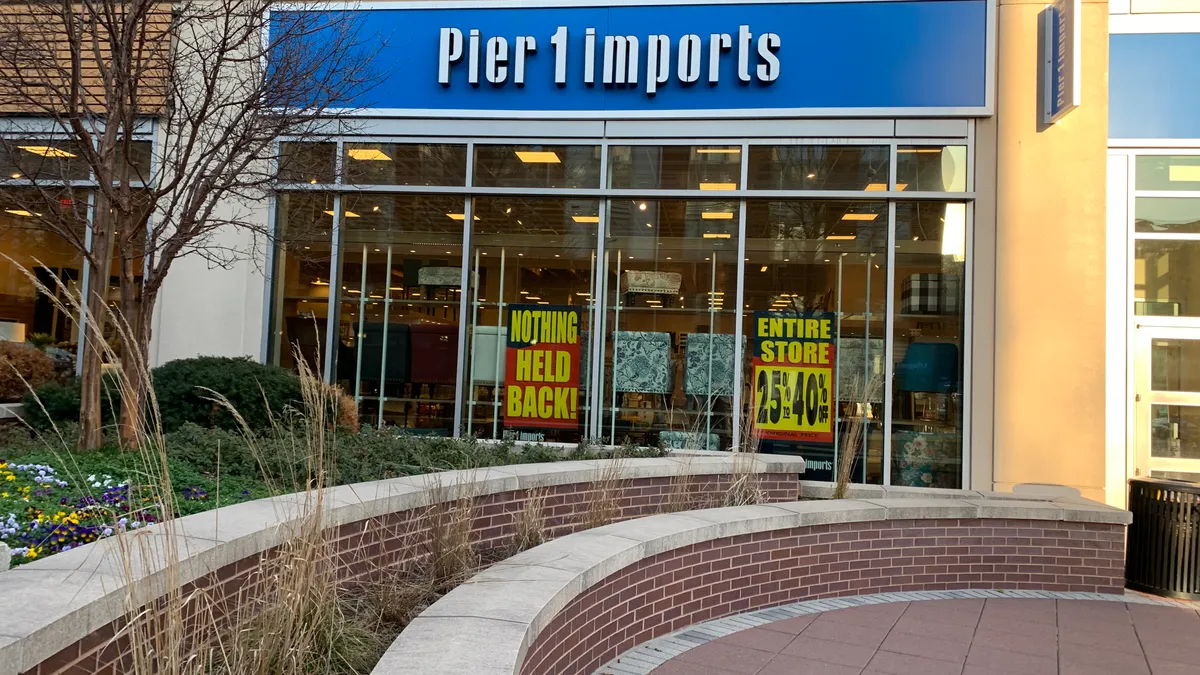Dive Brief:
-
Pier 1 filed for Chapter 11 bankruptcy protection on Monday, according to court documents filed with the Richmond division of the United States Bankruptcy Court for the Eastern District of Virginia.
-
The home goods retailer also announced it is looking for a buyer and pursuing a court-led sale, according to a company statement. Pier 1 is asking the court to set a deadline of around March 23 for all qualifying bids.
-
To fund it through bankruptcy, Pier 1 has commitments for about $256 million in debtor-in-possession financing from Bank of America, Wells Fargo National Association and Pathlight Capital.
Dive Insight:
Pier 1, which opened its first store in San Mateo, California, in 1962, was originally geared toward "post-World War II baby boomers looking for beanbag chairs, love beads, and incense," according to court papers. At its peak, the home goods chain operated more than 1,000 stores across the U.S. and Canada and offered consumers a treasure hunt-like experience.
However, as consumer behavior shifted, Pier 1's troubles grew. The home goods retailer faced competition from online entrants like Wayfair and Amazon, to TJX's HomeGoods, to mass merchants ramping up their own home goods offerings. These players were able to offer an elevated assortment with similar merchandise, but for less money than Pier 1. Since 2018, Pier 1 forfeited 0.5% market share in a set of key competitors, while Wayfair gained 3.9% during the same period, according to data provided to Retail Dive by Earnest Research.
Until last month when the retailer announced it would close up to 450 locations, Pier 1 was slow to trim its footprint, which analysts in the past have suggested could be as a result of extensive executive turnover through the years. Pier 1 said in court papers that it has already begun going-out-of-business sales at more than 400 locations and plans to close its Canadian operations entirely. This would leave Pier 1's footprint at about 540 locations.
In its most recent quarter, the retailer reported its long-term debt stood at $258.3 million. However, the real problem lies in its cash burn and term loan facility due next year. As of Nov. 30, Pier 1's available cash and equivalents had dwindled down to about $11 million.
As sales have continued to decline and losses mounted, the retailer brought in outside help with its turnaround efforts. In late 2018, Pier 1 brought on Credit Suisse Securities to advise the company's board with strategic alternatives, and in 2019 it hired AlixPartners and Kirkland & Ellis to help with turnaround efforts. And in the summer of 2019, it brought on financial adviser Guggenheim.
Pier 1 differs from other major retail bankruptcies like Sports Authority and Toys R Us in that it controls less of the market. Toys R Us, for example, accounted for $6.4 billion of the $54 billion U.S. toys and baby market, while Sports Authority represented $2.6 billion of the $70 billion U.S. sporting goods market, according to a January Telsey Advisory Group report. At the end of 2019, analysts at the firm placed Pier 1's sales at $1.3 billion, just a fraction of the massive $200 billion home furnishings market, which could limit the upside for competitors to Pier 1's closures and bankruptcy.















